
Kassel is a city on the Fulda River in northern Hesse, Germany. It is the administrative seat of the Regierungsbezirk Kassel and the district of the same name and had 200,507 inhabitants in December 2015. The former capital of the state of Hesse-Kassel has many palaces and parks, including the Bergpark Wilhelmshöhe, which is a UNESCO World Heritage Site. Kassel is also known for the documenta exhibitions of contemporary art. Kassel has a public university with 25,000 students (2018) and a multicultural population.

The Palace of Versailles is a world-famous palace located in Versailles, about 12 miles (19 km) west of Paris, France. The palace is owned by the French Republic and has since 1995 been managed, under the direction of the French Ministry of Culture, by the Public Establishment of the Palace, Museum and National Estate of Versailles. 15,000,000 people visit the Palace, Park, and Gardens of Versailles every year, making it one of the most popular tourist attractions in the world.

Jules Hardouin-Mansart was a French Baroque architect and builder whose major work included the Place des Victoires (1684–1690); Place Vendôme (1690); the domed chapel of Les Invalides (1690), and the Grand Trianon of the Palace of Versailles. His monumental work was designed to glorify the reign of Louis XIV of France.

The Tuileries Garden is a public garden located between the Louvre and the Place de la Concorde in the 1st arrondissement of Paris, France. Created by Catherine de' Medici as the garden of the Tuileries Palace in 1564, it was eventually opened to the public in 1667 and became a public park after the French Revolution. In the 19th, 20th and 21st centuries, it was a place where Parisians celebrated, met, strolled and relaxed.
Versailles refers to the Palace of Versailles, a royal château in Versailles in the Île-de-France region of France.
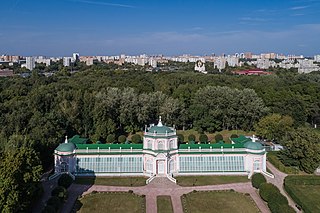
An orangery or orangerie was a room or a dedicated building on the grounds of fashionable residences from the 17th to the 19th centuries where orange and other fruit trees were protected during the winter, as a very large form of greenhouse or conservatory.

Schloss Charlottenburg is a Baroque palace in Berlin, located in Charlottenburg, a district of the Charlottenburg-Wilmersdorf borough.

The Orangery Palace is a palace located in the Sanssouci Park of Potsdam, Germany. It is also known as the New Orangery on the Klausberg, or just the Orangery. It was built on behest of the "Romantic on the Throne", King Friedrich Wilhelm IV from 1851 to 1864.

The Musée de l'Orangerie is an art gallery of impressionist and post-impressionist paintings located in the west corner of the Tuileries Gardens next to the Place de la Concorde in Paris. The museum is most famous as the permanent home of eight large Water Lilies murals by Claude Monet, and also contains works by Paul Cézanne, Henri Matisse, Amedeo Modigliani, Pablo Picasso, Pierre-Auguste Renoir, Henri Rousseau, Alfred Sisley, Chaim Soutine, Maurice Utrillo, and others.

French Baroque architecture, sometimes called French classicism, was a style of architecture during the reigns of Louis XIII (1610–43), Louis XIV (1643–1715) and Louis XV (1715–74). It was preceded by French Renaissance architecture and Mannerism and was followed in the second half of the 18th century by French Neoclassical architecture. The style was originally inspired by the Italian Baroque architecture style, but, particularly under Louis XIV, it gave greater emphasis to regularity, the colossal order of facades, and the use of colonnades and cupolas, to symbolize the power and grandeur of the King. Notable examples of the style include the Grand Trianon of the Palace of Versailles, and the dome of Les Invalides in Paris. In the final years of Louis XIV and the reign of Louis XV, the colossal orders gradually disappeared, the style became lighter and saw the introduction of wrought iron decoration in rocaille designs. The period also saw the introduction of monumental urban squares in Paris and other cities, notably Place Vendôme and the Place de la Concorde. The style profoundly influenced 18th-century secular architecture throughout Europe; the Palace of Versailles and the French formal garden were copied by other courts all over Europe.
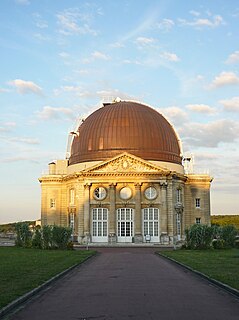
Meudon Castle, also known as the Royal Castle of Meudon or Imperial Palace of Meudon, is a French castle located in Meudon in the Hauts-de-Seine department. At the edge of a wooded plateau, the castle offers views of Paris and the Seine, as well as of the Chalais valley. Located between Paris and Versailles, in the heart of a hunting reserve, the castle has an ideal topography for large gardens. It had many successive owners from the Renaissance until the fall of the Second French Empire. It should not be confused with the Bellevue Castle, also located in Meudon.

The Château de Saint-Cloud was a château in France, built on a site overlooking the Seine at Saint-Cloud in Hauts-de-Seine, about 5 kilometres west of Paris. On the site of the former palace is the state-owned Parc de Saint-Cloud.
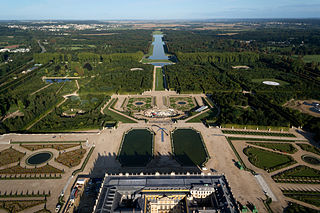
The French formal garden, also called the jardin à la française, is a style of garden based on symmetry and the principle of imposing order on nature. Its epitome is generally considered to be the Gardens of Versailles designed during the 17th century by the landscape architect André Le Nôtre for Louis XIV and widely copied by other European courts. Power in its connection to the French formal garden went beyond imposing it upon nature. Gardens like Versailles were symbols of political, monarchal power ,with one quote stating, The palace was built to impress. "Versailles is a mirage, a sumptuous and theatrical entertainment. It is also a manifestation of glory and power imposed to a great extent by art, luxury, and magnificence." This "manifestation of glory and power" The idea that art and culture can convey power, status, or influence is known as "soft power", or the kind of international influence that is leveraged through tools like culture and art.
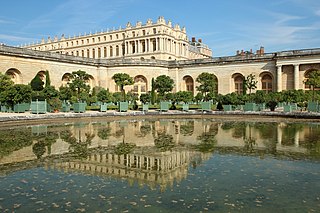
The Versailles Orangerie was built by Jules Hardouin-Mansart between 1684 and 1686, replacing Louis Le Vau’s design from 1663 – that is to say, before work on the Château had even begun. It is an example of many such prestigious extensions of grand gardens in Europe designed both to shelter tender plants and impress visitors. Louis XIV's gardens were no longer just a sanctuary for him to stroll through, but now the theatrical setting to entertain guests at court. In the winter, the Versailles Orangerie houses more than a thousand trees in boxes. During the winter the trees were housed in a cathedral-like space and during the coldest months, the gardeners would burn fires to heat the housing of the trees. In 1689 gardener Valentin Lopin created a device to transport and move the large orange trees. Most of the trees are citrus trees originally shipped from Italy, but there are many tender Mediterranean plants including oleanders, olive, pomegranate, and palm trees, totaling over 1,055 altogether. From May to October, they are put outdoors in the "Parterre Bas".
The Orangerie is an Orangery in Kassel, Hesse, Germany. It was built under Landgrave Charles between 1703 and 1711. Since then, it forms the northern corner of the Karlsaue park. Today it is used as an astronomy and physical cabinet.

The Baroque garden was a style of garden based upon symmetry and the principle of imposing order on nature. The style originated in the late-16th century in Italy, in the gardens of the Vatican and the Villa Borghese gardens in Rome and in the gardens of the Villa d'Este in Tivoli, and then spread to France, where it became known as the jardin à la française or French formal garden. The grandest example is found in the Gardens of Versailles designed during the 17th century by the landscape architect André Le Nôtre for Louis XIV. In the 18th century, in imitation of Versailles, very ornate Baroque gardens were built in other parts of Europe, including Germany, Austria, Spain, and in Saint-Petersburg, Russia. In the mid-18th century the style was replaced by the more less-geometric and more natural English landscape garden.

Residenz Ansbach, also known as Markgrafenschloß, is a palace in Ansbach, Germany. It was the government seat of the Margrave of Brandenburg-Ansbach. Today it is the administrative seat of the government of Middle Franconia. The Great Hall and the Orangerie in its garden serve as venues for the biennial music festival Bachwoche Ansbach.

Bessungen is a district in the South of the city of Darmstadt in Hesse.
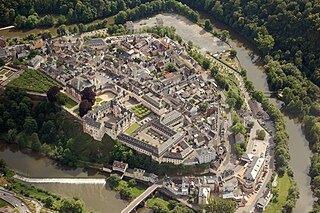
Schloss Weilburg is a Baroque schloss in Weilburg, Hesse, Germany. It is located on a spur above the river Lahn and occupies about half of the area of the Old Town of Weilburg. It contains the Hochschloss, built between 1530 and 1572, which is one of the best-preserved Renaissance palaces in Hesse. In the 1700s, the palace was expanded by John Ernst, Count of Nassau-Weilburg, and his builder, Julius Ludwig Rothweil. The buildings and gardens now belong to the Verwaltung der Staatlichen Schlösser und Gärten Hessen, and they can be visited as a museum on guided tours. Parts of the palace are venues for the music festival Weilburger Schlosskonzerte, which is named after the palace.

The Orangerie in Darmstadt, built around 1720, is a baroque palace building designed by the architect Louis Remy de la Fosse. Originally, it served as a winter shelter for citrus plants sensitive to the cold, which adorned the surrounding parkland in the summer months. The building was constructed with a one-storey hall open to the south, surrounded by single-storey rooms. The adjoining orangery park was designed under Ernest Louis, Landgrave of Hesse-Darmstadt by the Electoral Palatine court gardener Johann Kaspar Ehret from Heidelberg. The symmetrical Baroque grounds consist of three tiered garden parterres, wide axes with fountains and surrounding avenues. The sandstone gate of the former market palace forms the northern end.

















